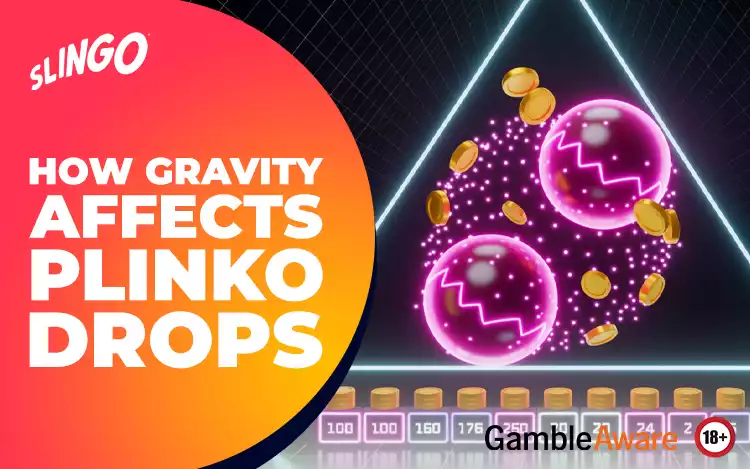Have you ever dropped a coin into a machine and watched it dance its way through pegs before landing in a random slot? That curious motion is more than chance—it’s physics at play. Plinko online may appear whimsical on the surface, but underneath it all lies one of nature’s most fundamental forces: gravity.
In this article, we’re delving into the gravity effect in Plinko and how it guides every drop, bounce, and turn. From the moment a ball is released at the top of the board to when it lands in a multiplier slot, gravity is quietly doing all the heavy lifting. We’ll explore how this force interacts with the board’s angles, pegs, and layout, especially in the digital versions of the game like those found at Slingo.com.
What Is Gravity’s Role in Plinko?
The Driving Force Behind Every Drop
Gravity is the invisible hand that pulls the Plinko ball down the board. As soon as you release the ball, it accelerates downward due to Earth’s gravitational pull. This acceleration gives the ball the energy it needs to interact with the pegs and navigate its unpredictable path.
In Plinko, gravity isn’t just present—it’s essential. Without it, the ball wouldn’t move downward, and the entire concept of the game would fall apart.
How Gravity Shapes the Descent
The Relationship Between Speed and Gravity
As the ball moves downward, it picks up speed. Gravity causes a uniform acceleration, which means the ball moves faster as it drops from peg to peg. This increased speed affects how it bounces, how far it ricochets off each peg, and how quickly it reaches the bottom.
This doesn’t mean it zooms straight to the end. The pegs slow its descent by redirecting its path—but gravity keeps the momentum going. The result? A zigzagging, natural-feeling motion that’s completely physics-driven.
Slingo’s Plinko Simulation
In Slingo’s version of Plinko, the virtual physics engine mirrors this gravitational motion. While the board is digital, it mimics real-world physics principles to provide that authentic feel. When players drop a ball in Slingo’s Plinko, it speeds up gradually, tumbles through triangular pegs, and reaches the bottom in a way that feels familiar and intuitive—all thanks to simulated gravity.
Gravity and the Triangular Pegs
Angular Deflections and Directional Shifts
When gravity pulls the ball downward, it inevitably causes the ball to collide with the pegs. Because the pegs in Plinko are triangular, each impact redirects the ball either left or right.
Gravity’s influence ensures the ball doesn’t hover or float—it keeps things moving. The angle of descent combined with the angles of the triangular pegs creates a cascade of possibilities. Each bounce is the result of a three-way interplay between the shape of the peg, the downward pull of gravity, and the momentum of the ball.
Gravity, Angles, and the Board Layout
The Sloped Surface: A Design of Purpose
Plinko boards are sloped for a reason. A flat board wouldn’t allow gravity to do its job properly. By setting the board at an angle, game designers ensure gravity can keep the ball in motion while still allowing for side-to-side movement as the ball bounces off pegs.
On Slingo.com, this design is mirrored in digital form. The board slope is carefully coded to ensure the right combination of vertical and lateral motion, keeping the descent natural while encouraging variation with each bounce.
Momentum Accumulation
The more the ball falls, the more momentum it gains. As it hits more pegs and angles, gravity keeps it moving at a steady pace. However, because pegs slow the motion with each bounce, there’s a balance between the pull of gravity and the resistance of the board. This balance is crucial—it’s what creates the feeling that anything can happen, even though gravity is pulling everything downward predictably.
Does Gravity Make Plinko Fairer?
Neutral Force, Unbiased Play
Gravity doesn’t favour the left or the right. It simply pulls downward. Because of this, it plays an important role in making Plinko a fair game. The outcomes are randomised due to peg collisions, not gravity’s direction.
The combination of gravitational descent and angled pegs ensures that no drop can be perfectly predicted. This is crucial when considering the fair design principles of games hosted by Slingo, where fairness and fun are prioritised equally.
Can You Use Gravity to Your Advantage?
The Illusion of Control
Some players believe that dropping the ball at a certain point might improve their chances of landing in a specific slot. But in reality, once gravity takes over, the ball’s path becomes subject to bounce dynamics, board angles, and speed—all of which are beyond player influence.
That’s why wins in Plinko can never be guaranteed. The gravity effect in Plinko ensures that while the force pulling the ball is consistent, the journey it takes will never be.
Comparing Gravity in Physical vs Digital Plinko
What’s Different?
In physical versions of Plinko, gravity is literal—you're watching an object fall through space. In digital versions like Slingo’s Plinko, gravity is simulated through a physics engine. But the mechanics are surprisingly similar:
|
Element |
Physical Plinko |
Slingo's Digital Plinko | |||
|
Gravity |
Real, natural pull |
Simulated, algorithm-driven | |||
|
Ball Movement |
Real bounces and motion |
Virtual, based on physics code | |||
|
Peg Interaction |
Physical collisions |
Digitally rendered physics | |||
|
Outcome Randomness |
Peg-driven unpredictability |
Peg-driven unpredictability |
Both systems rely on gravity to create the right pace, motion, and descent, but only one uses actual mass and weight—the other, code and design.
Why Gravity Is Central to Plinko's Enjoyment
We instinctively understand how objects fall. That’s why watching a Plinko ball descend feels so engaging—it mimics everyday physics we see all around us. The pull of gravity creates a pattern we recognise, even if the exact path is a mystery.
In digital games, replicating this feeling is key. Slingo’s Plinko works so well because it harnesses this familiarity while still embracing the randomness created by triangular pegs and angled boards.
Final Thoughts: Gravity Is the Unsung Hero of Plinko
The gravity effect in Plinko is subtle, yet essential. From controlling the ball’s descent speed to determining how it interacts with pegs and angles, gravity shapes every moment of the game. It ensures that the ball keeps moving, that no outcome can be repeated exactly, and that the experience remains fun and fair.
At Slingo.com, this natural motion is recreated through clever game design, simulating real physics to give players an engaging and dynamic experience every time they drop the ball. While strategy can guide your choices—such as risk level or starting point—it’s gravity, angles, and randomness that ultimately decide where the ball will land.
And remember: wins are never guaranteed. At the end of the day, it’s all about chance, movement, and letting gravity take its course.








